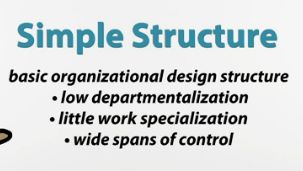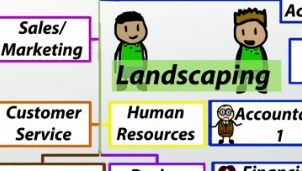Types of Traditional Organizational Designs: Simple, Functional & Divisional Designs
After you watch the video and know the material, click HERE for the quiz.
Choosing an organizational structure is an ongoing design process. In this lesson, you will learn to identify types of traditional organizational designs, including simple, functional and divisional designs.
Organizational Design
In another lesson, we discussed the fact that organizational structure refers to the type of framework that a company uses to distinguish power and authority, roles and responsibilities and the manner in which information flows through the organization. Once an organization has chosen its structure, it can move on to selecting the design. Organizational design is the process by which managers assess the tasks, functions and goals of the business, allowing them to make decisions about how to group people together to best and most efficiently achieve their objectives.
 |
To give you a better understanding of the organizational design concept, this lesson will define and discuss the first three designs, also known as traditional organizational designs, which include simple, functional and divisional design structures. To learn more about other design structures, make sure that you also watch the lesson on contemporary organizational designs, which include matrix, team and network designs.
 |
Simple Design Structure
The first type of traditional design is called simple structure. Simple structure is a basic organizational design structure with low departmentalization, little work specialization, wide spans of control, centralized authority (typically the owner has most of the power) and little formalization or rules that govern operation. Organizations that use a simple structure are typically flat, in that there are not many hierarchical levels such as in what you see on the screen now.
This diagram of a simple structure depicts a small start-up business, in which the simple structure is very common, with few employees and an owner who manages and controls the majority of the business functions. Because there are a limited number of employees in this landscaping company, it is necessary for each employee to perform multiple functions in various areas of the organization, creating little, if any, departmentalization. Policies, procedures and rules are limited in the simple structure due to the wide span of control and limited work specialization. Of course, once the landscaping company expands, it will more than likely outgrow its simple design structure and move into a more complex structure.
 |
Functional Design
The next type of traditional design an organization can utilize is the functional structure. The functional structure focuses on practical specialization whereby similar or related occupational specialties are grouped together (also referred to as departmentalization). Departmentalization groups workers with similar job roles into work units based on a product or service, activities performed by employees, level of skill or expertise, types of customers or resources. Explicit job titles, chain of command, reporting relationships and a well-defined channel of communication exist within these specialized work units in order to maximize their functionality.
A functional organization is designed on a strong hierarchy. Using the idea of departmentalization, the organization will be divided into individual departments, where each department has a specific function and all departments function independently to execute organizational goals. If you look at this diagram of a functional structure, you can see how departments, such as sales and marketing, finance and accounting, customer service, human resources, design and build, and maintenance, are grouped according to their specialization. If we look into one of these departments, let's take finance for example, we can see the same kind of individual job titles, reporting relationships and communication channels that also exist within this functional structure. The functional organizational design is most appropriate when an organization functions around only one product or service, such as landscaping. This allows those individually functioning units, such as sales and marketing, finance and accounting, customer service, human resources, design and build, and maintenance, to each complete one respective task surrounding the production and sales of that product or service.
 |
Divisional Design
A divisional design structure gives larger companies the capacity to separate large sections of the business into semi-autonomous units or divisions. These groups are self-managed and focused on a narrow aspect of the business with their own goals to accomplish. Examples of how divisions might be broken down include salespeople who cover the same geographical location or designers working on the same product line.
Unlike departments, divisions have more autonomy from the rest of the organization in that they often have their own top-level executive who manages the operations of the division. This autonomy allows managers to focus specifically on their individual unit, its resources and its results. Many believe that having their own top-level executive is what allows divisional structures to be so successful, because it ensures that someone who has power, authority and resources is available at all times.
 |
Lesson Summary
Let's review. Organizational design is the process by which managers assess the tasks, functions and goals of the business, allowing them to make decisions about how to group people together to best and most efficiently achieve their objectives. There are several forms of organizational design. This lesson covered traditional designs, including simple, functional and divisional design structures.
- Simple structure is a basic organizational design structure with low departmentalization, little work specialization, wide spans of control, centralized authority (typically the owner has most of the power) and little formalization or rules that govern operation.
- Functional structure focuses on practical specialization, whereby similar or related occupational specialties are grouped together (also referred to as departmentalization). Research and development, marketing, manufacturing, human resources and finance are examples of common groupings within a functional structure.
- Divisional design structure gives a larger company the capacity to separate large sections of the business into semi-autonomous units or divisions. These groups are self-managed and focused on a narrow aspect of the business with their own goals to accomplish.